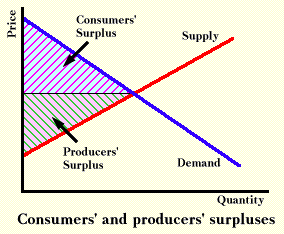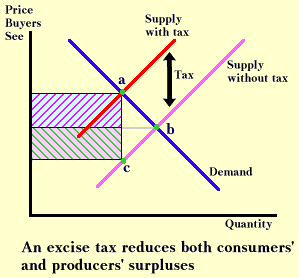
Notes on Taxes: Domestic and International (ECON 262)
Taxes often play a large role in changing the outcomes of markets. Therefore it is important to discuss them.
What is a tax?
Why do taxes exist?
1.
2.
3.
Remember: only governments levy taxes!
To levy a tax:
Tax incidence:
Statutory incidence:
But be careful, the government might levy a tax on Bob, but that does not mean that Bob actually pays the tax.
Tax shifting:
Examples:
Economic incidence:
Let's discuss the economic definitions of a few types of taxes (some of the most popular):
Income tax:
Sales tax:
Excise tax:
Tariff (could be on exports or imports):
An earmarked tax:
Example:
Economists are interested in the incidence of taxes. But not simply who actually pays, but also the economic incidence. The type of tax that is used by the government will impact both. Let's look at some examples.
Progressive tax:
Example (statutory incidence):
U.S. Federal Income Tax - 2017

Who Pays? (Source: National Taxpayer's Union)
Example (economic incidence of a progressive income tax):
Regressive tax:
Example (statutory incidence):
State Sales Taxes (Source: Federation of Tax Administrators)
Example (economic incidence of a sales tax):
Flat or Proportional Tax:
Example (statutory incidence):
State Income Taxes (Source: Federation of Tax Administrators)
Example (economic incidence of a flat income tax):
Analyzing Taxes
Note how the economic incidence of taxes typically relates to how taxes change people's incentives. The type of tax that is levied is called a tax rule. Therefore, we can use our model to analyze tax rules.
R - I - A - O
Using the model, why might we see less tax revenue when a tax rate (for example an income tax rate) is increased?
Relate your answer to the elasticity of labor supply.
What about a sales tax? Relate your answer to the elasticity of demand.
Let's Apply the Supply and Demand Model by Analyzing A Couple of Taxes
Application One: Analysis of an Excise Tax
First - examples: State Excise Taxes (Source: Federation of Tax Administrators)
How will the government try to "sell" the tax to the public? Usually by claiming that these would be "sin taxes" -- people "shouldn't" buy these goods anyway so the government will tax them in order to decrease demand. In many cases this is propaganda. Why? Let's find out......
An excise tax is levied on the seller of a product (say gasoline). Where will the incidence of the tax fall? It depends upon the price elasticity of demand for the product. The more inelastic the good is, the more the consumer will pay the tax (ceteris paribus).
Also, the more inelastic the good is, the more revenue the government will obtain from the tax (which is why you typically see excise taxes on very inelastic goods -- like gas, cigs, alcohol, etc.). In some cases -- there is social engineering, but in most cases, excise taxes are high revenue generating taxes for governments.
Excise Tax Analysis and Consumer and Producer Surplus
First - a couple of new concepts- Consumer and Producer Surplus (the graphical representation of the benefits or gains from trade)
Consumer Surplus:
Producer Surplus:

What is there is an increase in Demand (shift) and the price increases? Notice that the consumer and producer surplus change (some of the consumer surplus becomes producer surplus, etc. -- but there is no "loss" overall.
But -- when a market shrinks and there is less trade -- the individuals in that market lose the benefits from trade. However, if this is caused by supply and demand changes in the market -- it means those resources have gone elsewhere and therefore benefits are being created in other markets. We can say this is "good" because it comes about because of consumers changing their preferences, etc.
However, what if a decrease in trade in a market comes about because of government involvement -- from say, a tax. This loss of trade and therefore benefit of consumer and producer surplus is known as a:
"Deadweight" loss:
Graphically - An excise tax is levied on the sellers of the good:

Let's analyze an excise tax on cigs.
The government levies an excise tax on the sellers of cigs:
Graph:
How much of the tax is paid by consumers?
Producers?
What is the total tax revenue the government will collect?
This is called a transfer payment:
Is there a deadweight loss due to a loss of consumer and producer surplus (loss of trade) that was not generated by consumer preferences? Where is it?
Now let's assume (for the sake of understanding) perfect demand elasticity with respect to price:
Graphically:
What changes? Government revenue? Who pays the tax? Consumer surplus? Deadweight loss?
Criticisms of the model. What does the graphically analysis leave out?
1. What about administrative and compliance costs by suppliers and by the government?
2. A second problem with this analysis is that for some cases a simple supply and demand graph may not be appropriate to examine the consequences of a tax. The analysis assumes that any effects on other markets can be ignored. A tax on item A may affect the price of item B, which in turn may alter the supply or demand of item A.
Can you think of an example with respect to our analysis of the cig market?
Application Two: International Barriers to Trade
Tariffs:
ad valorem:
Approximately 96 percent of U.S. merchandise imports are industrial (non-agricultural) goods. The United States currently has a trade-weighted average import tariff rate of 2.0 percent on industrial goods ( source: Office of the United States Trade Representative - May 2017).
Quotas:
Example: U.S. Sugar Quotas https://www.fas.usda.gov/newsroom/usda-increases-fiscal-year-2017-specialty-sugar-trq
Basically the outcomes or consequences of tariffs and quotas are very similar (in terms of who benefits and who loses and how resource allocation is changed). There are slight differences.
What are some of the arguments that governments, firms or workers make for tariffs and/or quotas? (See chapters 30 and 31 in MBN)
Graphical analysis:
Tariff:
Quota:
Who benefits? Who loses from tariffs and quotas? Why would the prices of U.S. produced goods and services be higher when tariffs are "protecting" those markets?